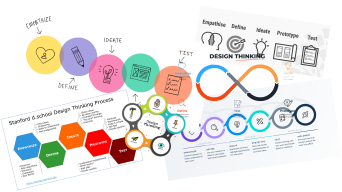Design thinking goes by a few names, but at its core, it is a series of steps to ensure that products and solutions are suitable for their target demographic, and of value to society.
Documented by the Stanford school of design, at its core aims to find root causes of problems. By doing this solutions can be applied to a broader range of flow-on effects, rather than being a superficial answer to the immediate problem.

Stages in Design Thinking
As a process design thinking is moved through linearly start to finish, you can linger in a section, or double back if there’s a hurdle or issue found with the current solution.
In terms of focus, the design thinking process goes through a series of divergent and convergent stages. Finding a broad range of problems, narrowing down to a root cause, considering a broad range of solutions, and narrowing to a minimum viable product.
Empathise
The core of user-centred design, and design thinking, is the person with a problem. This means that empathising with them and understanding the problem should be your number one priority. It is important to follow the problem to its source at this stage, and not necessarily “take the user’s word”.
For example, if a user is emptying the rubbish into the bin every night, their complaint may be that it’s too high. Upon investigation, you may find that the reason the bags are so heavy in the first place is that people aren’t recycling properly or perhaps items are being thrown out that should be diverted elsewhere. Perhaps it’s not that the bins are heavy, but that they feel heavy because the user is tired and not getting enough breaks during the day.
Define
Once you have a thorough understanding of the problem it’s time to define what you will do to solve it. This is normally done through a definition statement outlining the user, the problem, and other integral characteristics. It is important to be broad enough for creativity, but narrow enough for evaluation. e.g. “How can we…so that…”
How can we improve recycling rates in hospitals
so that lifting injuries are reduced.
The goal of the definition statement is to set parameters for the ideation and some criteria for their evaluation. It should be specific enough to keep ideas directed towards a solution, while still broad enough to not stifle creativity.
Ideate
Ideas are the source of solutions and it’s important that you come up with as many ideas as possible, so that even when you abandon them you have a repository to draw upon. A great tool for this is SCAMPER.
Ideation is a quantity game. Sometimes it’s the worse ideas that turn into the most successful products. Take Uber as an example. If someone told you that rather than a taxi a stranger will come and pick you up from your home most people would have been creeped out. Add tracking, ratings, and a handy app and you end up with Uber. Take away the anticompetitive behaviour and you might even get a good company.
If you can identify a problem with an idea and then solve it this will lead you to a better idea. Just don’t get too caught in the weeds or you might never move forward. Keep the definition statement in mind.
Prototype
Once you have an idea worth perusing it’s time to build it. There are a number of different techniques that can live under this heading such as Agile, minimum viable product, and Lean to name a few.
It’s best to start prototyping on paper using a sketch or storyboard. This gives the lowest barrier to entry and can identify problems before any significant investment in the prototype has been made. Major companies have failed at this stage (notably Juicero who created a car crusher instead of a juicer) and invested huge amounts without any testing or investigation of their core concept. Sometimes in the race to market, it’s the slow and steady who wins. But a simple paper test for your idea can be enough to pivot and still make it there first.
Test
This is the evaluation stage. Before this point, you should be measuring the completeness of your idea, and determining if each component is fit for purpose. When you get to this stage it’s important to test the user’s experience with your solution, and not how the solution holds up to being used.
Evaluation is a part of testing, and once an idea has been evaluated as successful or useful it’s time to send it out. It’s not over though. Once you have it in the market it’s time to look for any problems and feed them back into the design thinking process.
